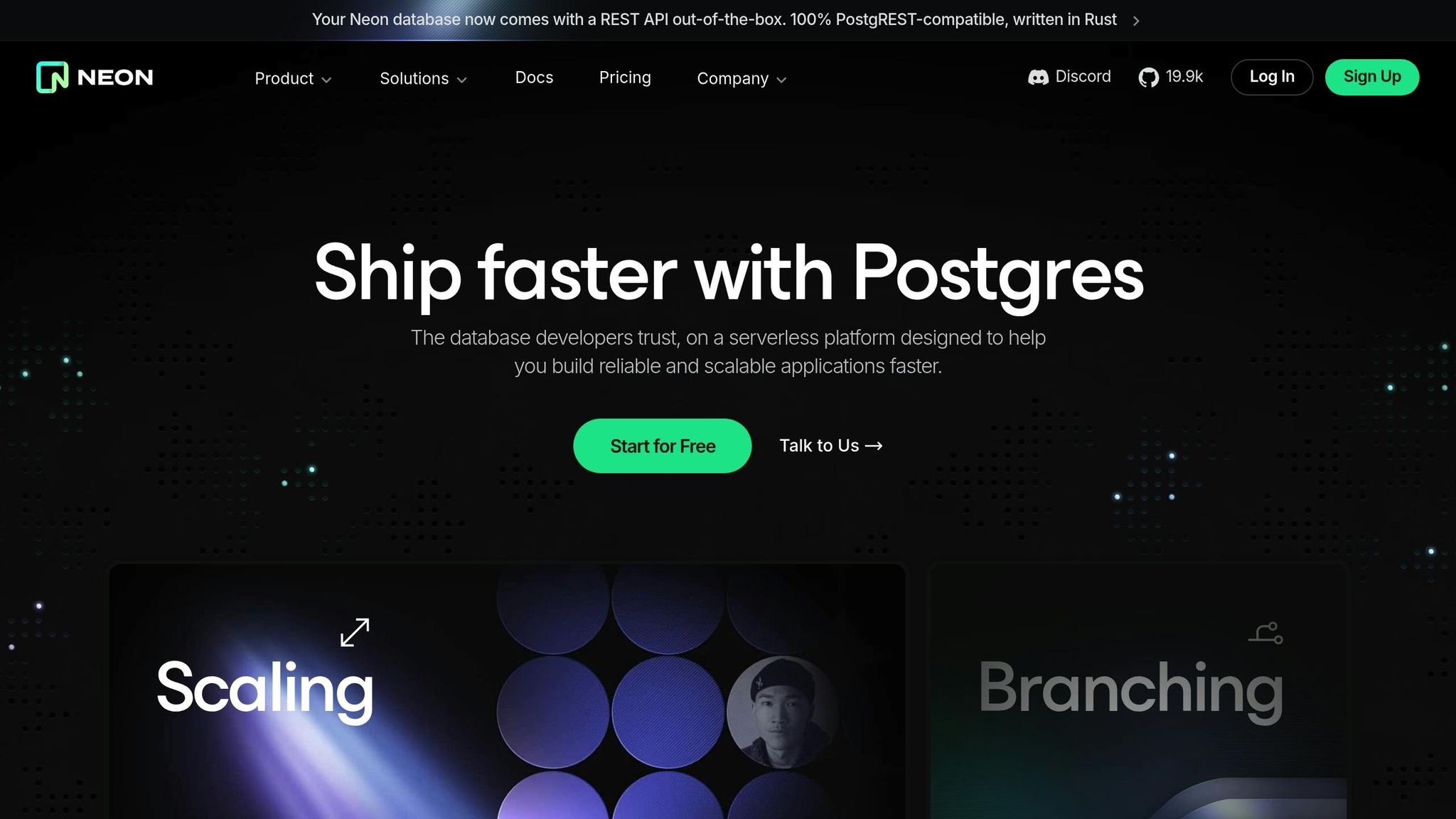Scaling Construction SaaS: Database Design for 10M+ Daily Transactions
Taher Pardawala October 7, 2025
When building a Construction SaaS platform that handles over 10 million daily transactions, database design is critical. The challenge lies in ensuring uptime, accuracy, and performance while managing unpredictable spikes, complex workflows, and multi-tenancy. Here’s a quick breakdown of what matters most:
- Reliability: Ensure 99.9% uptime to avoid costly delays for contractors relying on real-time data.
- Scalability: Handle growth from small contractors to enterprises with 5,000+ users across multiple sites.
- Performance: Address bottlenecks in write-heavy operations (e.g., logs, time entries) and read-heavy tasks (e.g., compliance reports).
- Data Integrity: Maintain ACID compliance for accurate transactions, minimizing financial risks.
- Multi-Tenancy: Balance data isolation and cross-project insights for hundreds of clients.
Key strategies include hybrid schema designs (balancing normalization and denormalization), efficient indexing, query optimization, and advanced scaling techniques like partitioning, sharding, and load balancing. For multi-tenancy, shared, separate schemas, or dedicated databases can be used based on client needs. By combining these methods, platforms can ensure performance, reliability, and growth.
Read on for schema design tips, indexing techniques, and scaling solutions tailored for Construction SaaS platforms.
Building Scalable Database-per-Tenant SaaS Architectures in Postgres With Neon and AWS

Schema Design Best Practices for High-Volume Transactions
When your database needs to handle over 10 million daily transactions, careful planning is essential. For construction SaaS platforms, the challenge lies in balancing data accuracy with high performance. The way you design your schema directly affects how well your platform scales to meet these demands.
Normalization vs. Denormalization Trade-offs
Normalization is great for minimizing redundancy and ensuring consistent updates, especially in OLTP (Online Transaction Processing) systems. It’s particularly useful for managing data like contractor details, equipment logs, and time entries[1].
On the other hand, denormalization introduces some redundancy by merging data into fewer, broader tables. This approach can significantly boost query performance for OLAP (Online Analytical Processing) tasks or real-time dashboards, where quick data access often outweighs the cost of complex joins[1].
The sweet spot often lies in a hybrid approach. By keeping a normalized core for data integrity and creating denormalized views or summary tables for high-speed read operations, you can achieve both accuracy and responsiveness[1][2]. However, it’s important to strike the right balance – too much normalization can slow queries due to excessive joins, while over-denormalization can lead to data drift, costly write operations, and challenges when modifying your schema[1].
These trade-offs are key to designing a schema that efficiently handles high transaction volumes.
Structuring Construction Data Workflows
Once you’ve balanced normalization and denormalization, the next step is tailoring your schema to the unique demands of construction data workflows. Transactional data, such as time entries, equipment usage, and material purchases, should be strictly normalized to avoid errors that could be expensive to fix.
Handling project hierarchies adds another layer of complexity. A single construction project often includes multiple phases, tasks, subtasks, and individual work items. To support this nested structure and enable efficient aggregation at different levels, consider using adjacency lists or nested sets, depending on your platform’s read and write patterns.
Time-series data is another critical component. Equipment sensors generate continuous streams of location and usage data, employees clock in and out, and environmental factors like weather can impact schedules. Managing this flood of time-sensitive data often benefits from specialized time-series tables with partitioning strategies that help maintain performance as data grows.
Construction projects also produce a wealth of documents and media, such as photos, blueprints, contracts, and compliance records. A common approach is to store file metadata in a relational database while keeping the actual files in object storage. This hybrid setup lets you combine the query power of structured data with the scalability of cloud-based storage.
Multi-Tenancy Database Strategies
For construction SaaS platforms, multi-tenancy is a must, as they often serve multiple companies with strict data isolation requirements. The approach you choose affects both security and performance.
- Shared database with a shared schema: This is the most resource-efficient option. A
tenant_idcolumn ensures data isolation, but heavy usage by one tenant can impact others. It’s a good fit for smaller companies with similar usage patterns. - Shared database with separate schemas: This setup provides better isolation by giving each tenant its own schema within the same database instance. It’s still cost-effective but offers more flexibility.
- Separate databases: For maximum isolation and customization, each tenant gets its own database. While this approach suits large companies with specific performance needs, it comes with higher infrastructure costs and complicates cross-tenant analytics.
For platforms managing over 10 million daily transactions, a hybrid multi-tenancy strategy often works best. For enterprise clients requiring high isolation, separate databases are ideal. Meanwhile, smaller contractors can share resources to keep costs down. Modern databases like PostgreSQL also support row-level security, adding an extra layer of protection by automatically filtering data based on user context.
Indexing and Query Optimization for Scalability
For a construction SaaS platform managing millions of daily transactions, every millisecond matters. Poorly designed indexing and inefficient queries can drag down performance. The trick is knowing where to place indexes and how to fine-tune queries to handle high traffic without overloading your database.
Creating Efficient Database Indexes
Indexes can significantly speed up queries, but they need to be thoughtfully implemented. In construction platforms, certain query patterns tend to repeat, making specific indexing strategies essential.
- Composite Indexes: These are perfect for queries that filter by multiple criteria. Instead of creating separate indexes for fields like
project_id,date, andemployee_id, a composite index combining(project_id, date, employee_id)can handle queries involving any combination of these fields, as long as they follow the leftmost prefix rule. - Time-Based Queries: Construction platforms often rely on time-specific data, such as daily timesheets or equipment usage reports. Partial indexes – like one created for
WHERE created_at >= '2024-01-01'– focus on recent data, reducing index size and improving performance. Older data remains accessible through full table scans when necessary. - Covering Indexes: These include all the columns a query needs, eliminating the need to access the main table. For example, an index on
(project_id, employee_id, hours_worked, date)allows the database to fetch summary information, like total hours worked per project, directly from the index. - Expression-Based Indexes: If your queries often involve calculated fields, like filtering projects by completion percentage or equipment by age, creating indexes on these computed values saves the database from recalculating them every time.
However, indexes come with trade-offs. They consume storage and can slow down write operations like inserts and updates. Focus on indexes that support your most frequent and critical queries rather than trying to optimize every possible scenario.
Query Optimization Techniques
Each database system brings its own strengths and requires tailored optimization strategies, especially for high-transaction construction platforms.
- PostgreSQL: Known for handling complex analytical queries, PostgreSQL offers tools like
EXPLAIN ANALYZEto pinpoint slow operations such as sequential scans or nested loops. For large aggregations, materialized views that refresh periodically can replace real-time computations. Keep table statistics updated with regularANALYZEruns to help the query planner make better decisions. - MongoDB: Ideal for document-based data, MongoDB performs best when queries align with the document structure. Embedding related data, such as project phases within project documents, avoids resource-heavy
$lookupoperations. Use the aggregation pipeline for advanced reporting but monitor memory usage, as stages without indexes can consume significant resources. Theexplain()method helps verify if indexes are being used effectively. - DynamoDB: This database requires designing around access patterns rather than flexible querying. For example, use
project_idas a partition key for project data oremployee_idfor time-tracking systems. Global Secondary Indexes (GSI) should be used sparingly to support alternative access patterns. With its low-latency performance, DynamoDB is well-suited for real-time features like live dashboards.
To further optimize queries, consider batching operations. Instead of processing one record at a time, group inserts or updates into batches of 100-500. This approach works well for bulk actions like end-of-day timesheet submissions or equipment data imports.
Lastly, implement connection pooling to handle concurrent users efficiently. A pool of reusable connections prevents the overhead of opening and closing connections repeatedly. For platforms with seasonal spikes, configure pools to scale up during busy periods and shrink during slower times.
Eliminating Query Bottlenecks
High-traffic environments, like those in construction platforms, often face unique challenges during peak times – think shift changes, project deadlines, or end-of-day data syncs. Addressing bottlenecks proactively is key.
- Lock Contention: When multiple users try to update the same records, conflicts can arise. To avoid this, use row-level locking or redesign your schema. For instance, instead of updating a single project status record, maintain append-only logs to prevent conflicts.
- Read Replicas: Offload read-heavy operations, like reporting and dashboards, to replicas. This keeps the primary database focused on real-time tasks, such as timesheet submissions.
- Query Timeouts: Set strict time limits for user-facing queries (e.g., 2-5 seconds). Background reporting jobs can have longer timeouts, but ensure users can cancel slow-running queries to avoid unnecessary resource consumption.
- Caching Layers: For frequently accessed but rarely changing data – such as project details or equipment specs – use caching tools like Redis or Memcached. These provide sub-millisecond response times while reducing database load.
- Continuous Monitoring: Keep an eye on query performance with alerts for anomalies like unusually long execution times, lock waits, or connection pool issues. Construction platforms often follow predictable usage patterns, so baselines can help you spot deviations quickly.
Finally, use prepared statements for repetitive queries. This reduces parsing overhead and guards against SQL injection, a critical concern in high-transaction environments.
Database Scaling: Partitioning, Sharding, and Load Balancing
Managing millions of daily transactions on a single server? Not a chance. To handle such high demand, you need to distribute the workload across multiple systems. That’s where partitioning, sharding, and load balancing come into play. These strategies transform a single point of failure into a robust, scalable system.
Data Partitioning Methods
Partitioning is all about breaking large tables into smaller, more manageable pieces, all within the same database. For construction platforms, this approach works particularly well due to the natural boundaries in construction data.
Time-based partitioning is especially effective for construction workflows. Think about project timesheets, equipment logs, or progress reports – they naturally group by date ranges. With PostgreSQL’s built-in partitioning, you can create monthly or quarterly partitions automatically. For instance, timesheet data from January 2025 can live in one partition, while February 2025 data resides in another. This setup ensures that when you query a specific date range, only relevant partitions are scanned, cutting query times from seconds to milliseconds.
Geographic partitioning is another logical choice for construction companies operating in multiple regions. For example, project data can be partitioned by state or region – California projects in one partition, Texas projects in another. This keeps related data together and allows for region-specific optimizations.
Project-based partitioning works well for firms managing hundreds of projects. Each major project gets its own partition, preventing large projects from slowing down queries for smaller ones. It also simplifies data archival – completed projects can be moved to cold storage as entire partitions.
Partition pruning is a game-changer here. When querying for specific data – say, timesheets from March 2025 – the database engine automatically skips irrelevant partitions, speeding up queries and reducing unnecessary disk reads. But partitioning isn’t without its challenges. Cross-partition queries can be slower, and over-partitioning can hurt performance due to metadata overhead. Careful planning is key, and your partition keys should align with your most common query patterns.
Sharding for Distributed Workloads
Partitioning works within a single server, but when you outgrow even the most powerful hardware, sharding steps in. Sharding distributes data across multiple servers, making it essential for scaling distributed workloads.
Horizontal sharding splits data by rows across different database instances. For construction SaaS platforms, tenant-based sharding is often the go-to method. Each construction company (tenant) is assigned to a specific shard based on their company ID. For example, you could use company_id % number_of_shards to determine the shard. This keeps all of a company’s data – projects, employees, and equipment – on the same shard, avoiding complex cross-shard queries.
Range-based sharding is another option, especially for time-series data. Recent data (e.g., the last three months) can live on high-performance SSDs, while older data is stored on cheaper, slower disks. This approach balances speed with cost.
However, sharding comes with its own challenges, particularly cross-shard queries. For instance, generating a report that combines data from multiple construction companies may require querying and merging results from several shards, which adds complexity and can slow performance. A well-thought-out sharding strategy can minimize these issues.
Shard rebalancing is another consideration. As your platform grows, some shards may become overloaded while others remain underutilized. Planning for shard rebalancing from the start is crucial. MongoDB simplifies this process with its built-in sharding capabilities, automatically distributing data based on a shard key like company_id and handling rebalancing as needed. For PostgreSQL users, tools like Citus enable distributed databases while maintaining SQL compatibility, making it a strong choice for platforms already using PostgreSQL.
Load Balancing for High Transaction Volume
Partitioning and sharding handle data distribution, but what about traffic spikes? That’s where load balancing shines. It ensures no single server gets overwhelmed during peak times, like shift changes at 7:00 AM and 5:00 PM or end-of-week reporting.
Read replicas are the backbone of load balancing. The primary database handles all write operations, while read replicas handle queries for reports, dashboards, and analytics. For example, a typical setup might include one primary server and 2-3 read replicas, depending on your read-to-write ratio. Most construction platforms are read-heavy, making read replicas an efficient solution. By routing read queries to replicas and write queries to the primary server, you can handle high traffic more effectively.
Tools like PgBouncer (for PostgreSQL) and ProxySQL (for MySQL) use connection pools to prevent overload during traffic surges. These tools reuse database connections across multiple client requests, reducing the overhead of opening and closing connections.
Geographic load balancing is also beneficial for distributed teams. For example, read replicas can be placed in different regions – West Coast, East Coast, and Central US. A project manager in Seattle would experience faster response times from a West Coast replica than from a server located in Virginia.
Failover mechanisms are critical for high availability. If the primary database fails, one of the read replicas can be promoted to primary within minutes. Automated failover tools monitor the database’s health and switch traffic seamlessly to minimize downtime.
For even more control, application-level load balancing allows you to route queries intelligently. Real-time timesheet submissions can go to the primary server, while historical reporting is directed to replicas, and analytics queries are sent to dedicated analytical databases.
To monitor load balancing effectiveness, track metrics like query response times, connection pool utilization, and replica lag. Replica lag, which measures the delay between writes on the primary and their appearance on replicas, should ideally stay under 1-2 seconds for platforms where real-time data is critical.
During peak periods, dynamic scaling can help. Cloud providers like AWS RDS and Google Cloud SQL let you automatically spin up additional read replicas to handle increased demand, scaling back down during quieter times to save costs.
sbb-itb-51b9a02
Maintaining Data Integrity and Availability
In a system processing over 10 million transactions, even a minor database issue can cause chaos – stopping workers from clocking in, disrupting project updates, and throwing equipment tracking off course. Keeping data reliable and accessible is crucial to smooth operations.
ACID Compliance and Transaction Management
To keep data sound under heavy use, following ACID principles is non-negotiable. These ensure transactions are reliable, even in the most demanding conditions.
- Atomicity: A transaction completes fully or doesn’t happen at all. For instance, if a worker submits a timesheet with hours split across multiple projects, every entry must be saved together – or none of them are.
- Consistency: All transactions must follow set business rules. For example, if daily hours can’t exceed a limit, the system rejects entries that break this rule.
- Isolation: Transactions happening at the same time don’t interfere with each other. When multiple managers update an equipment schedule at once, each sees accurate, conflict-free data.
- Durability: Once a transaction is saved, it stays saved – even if the system crashes. For example, a critical report remains intact after being committed, no matter what happens next.
Modern databases like PostgreSQL use Multi-Version Concurrency Control (MVCC) to allow simultaneous reads and writes without locking users out. Tools like PgBouncer help manage connections, and batching transactions into smaller groups reduces system strain while boosting efficiency.
Backup and Disaster Recovery Planning
Data is the backbone of operations, so losing it isn’t an option. Beyond ensuring transaction accuracy, you need robust backup systems to protect against data loss.
Automated daily backups, paired with point-in-time recovery via Write-Ahead Logging (WAL), minimize potential losses. For high-traffic systems, frequent incremental backups during busy hours add an extra layer of security.
To guard against localized disasters, geographic redundancy replicates data across different regions. Regularly testing backups in controlled environments ensures recovery plans work when needed.
Cost management is also key. Implement retention policies that align with legal and operational needs, and consider tiered storage solutions like Amazon S3 Intelligent Tiering. These automatically move older backups to cheaper storage options, saving money without compromising accessibility.
High Availability with Failover Systems
Unexpected downtime can grind operations to a halt, leading to major costs. To avoid this, high availability setups are essential, ensuring your systems stay online even under pressure.
A primary–replica architecture keeps all write operations on the primary database, while synchronized replicas stand by, ready to take over. Tools like Patroni (for PostgreSQL) or MySQL Router (for MySQL) monitor database health and handle automatic failovers when needed.
Health checks keep an eye on CPU usage, disk I/O, memory, and query performance. Alerts for performance dips allow teams to address issues before they escalate. Tools like etcd or Consul prevent "split-brain" issues, where multiple nodes mistakenly act as the primary database.
To maintain seamless operations during failures, use read replicas and load balancers to redirect traffic automatically. Monitoring platforms like Datadog or New Relic notify your team instantly when failovers occur.
For systems spread across multiple regions, failover setups can reroute traffic to backup locations during outages. Establishing clear failback procedures and running regular recovery drills ensures your team is ready to handle disruptions smoothly.
Database Technology Comparison for Construction SaaS
Choosing the right database technology is a crucial decision for managing millions of daily transactions in a construction SaaS platform. Each database comes with its own strengths and trade-offs, directly influencing performance, scalability, and costs. Here’s a breakdown of the top contenders and how they stack up.
PostgreSQL is a great fit for platforms that need to handle complex queries and enforce strict data consistency. It provides advanced indexing, JSON support, and strong ACID compliance, making it perfect for diverse workflows like project management or equipment tracking. Its ability to maintain data integrity while supporting concurrent access is essential for teams working simultaneously.
MongoDB is well-suited for handling diverse data structures. Its document-based design is ideal for storing project documents, inspection reports, or equipment specs without being locked into rigid schemas. With built-in horizontal scaling, MongoDB can handle traffic spikes during busy construction seasons with ease.
Amazon DynamoDB stands out for its predictable performance and automatic scaling, making it a strong choice for workloads with fluctuating demands. Its serverless nature minimizes administrative tasks, allowing teams to focus on other priorities.
Comparison Table: Scalability, Performance, and Cost
| Feature | PostgreSQL | MongoDB | DynamoDB |
|---|---|---|---|
| Scalability | Vertical scaling with read replicas; horizontal scaling requires partitioning | Native horizontal scaling with sharding | Automatic horizontal scaling |
| Query Performance | Excellent for complex joins and analytics | Good for simple queries; struggles with complex joins | Fast for key-value lookups; limited query flexibility |
| Consistency Model | Strong consistency (ACID compliant) | Configurable consistency levels | Eventually consistent (strong consistency available) |
| Cost Structure | Open source; infrastructure costs only | Open source + optional Atlas hosting fees | Pay-per-request pricing model |
| Data Structure | Relational with JSON support | Document-based (BSON) | Key-value and document store |
| Maintenance Overhead | Moderate; requires database administration | Low to moderate depending on deployment | Minimal; fully managed service |
| Best for Construction SaaS | Complex reporting, financial data, compliance tracking | Project documents, flexible schemas, rapid prototyping | Real-time notifications, user sessions, simple lookups |
Which Database Fits Your Needs?
For construction SaaS platforms with high transaction volumes, PostgreSQL often takes the lead. Its strong support for complex queries and advanced reporting tools makes it a dependable choice for mission-critical workflows like compliance tracking or financial data management.
On the other hand, MongoDB shines in scenarios where flexibility is key. If your platform needs to handle unstructured data or adapt quickly to changing requirements, its schema-less design simplifies the process and reduces migration headaches.
Meanwhile, DynamoDB is ideal for applications focused on speed and simplicity. Whether it’s managing user sessions, real-time notifications, or IoT data, its automatic scaling and pay-per-request pricing model make it a cost-effective and low-maintenance option.
Ultimately, the best choice depends on your platform’s specific needs, your team’s expertise, and how you plan to scale in the future. Many successful construction SaaS platforms combine these technologies, using each where it performs best. This hybrid approach ensures you get the most out of your database infrastructure.
AlterSquare‘s Approach to Scalable SaaS Engineering

Creating a construction SaaS platform capable of managing over 10 million daily transactions is no small feat. It requires a well-thought-out scalability strategy from the very beginning. AlterSquare has developed a methodology that combines expert engineering practices with proven frameworks to ensure your database grows seamlessly alongside your platform.
Phased Delivery Framework
Scalability isn’t something to be tacked on later – it needs to be baked into the system from day one. AlterSquare’s I.D.E.A.L. framework is designed to make this happen. By breaking database challenges into distinct, manageable phases, this approach ensures your platform’s foundation is built to handle growth effectively.
Here’s how the framework works:
- Discovery: Analyze workflows to pinpoint bottlenecks.
- Design: Create optimized schemas and multi-tenant architectures.
- Development: Gradually implement features to ensure stability.
- Launch: Test performance under simulated high-demand conditions.
- Post-launch: Continuously monitor and fine-tune the system.
During the discovery phase, AlterSquare digs deep into your construction workflows, identifying transaction patterns and potential scalability hurdles. Whether it’s managing real-time updates for equipment tracking or processing project status changes across multiple job sites, the team ensures bottlenecks are addressed before they become issues.
As launch approaches, the focus shifts to rigorous load testing. Simulating peak traffic, AlterSquare ensures your database can handle simultaneous spikes in project updates, equipment logs, and financial transactions without breaking a sweat.
Post-launch, the work doesn’t stop. AlterSquare monitors query performance, adjusts indexing based on actual usage, and introduces new scaling strategies as transaction volumes grow. This ongoing attention ensures your database remains fast and reliable as your platform evolves.
Engineering-as-a-Service for Scalability
AlterSquare takes scalability a step further with its Engineering-as-a-Service model. Instead of just offering advice, their engineering team becomes an integral part of your business. They don’t just consult – they take ownership of your database’s performance and growth.
This model leverages modular architectures, allowing individual components to scale independently. For instance, you can scale your reporting database separately from your transactional systems. This ensures that analytics-heavy queries won’t interfere with real-time operations like project updates.
From day one, AlterSquare’s engineers design systems with scalability in mind. They implement strategies like partitioning to distribute transaction loads, caching layers to ease database pressure during peak times, and robust backup and disaster recovery systems to safeguard your data.
High concurrency and transaction management are handled with care, ensuring your platform maintains consistency even under heavy usage. Disaster recovery plans include automated backups, failover systems, and data replication across multiple regions. Redundant database configurations, load balancing, and proactive monitoring ensure high availability, minimizing downtime during critical project phases – a must in the construction industry where delays can be costly.
As your platform grows, AlterSquare’s team continues to optimize performance. They analyze real-world usage patterns, refine system configurations, and implement upgrades to maintain speed and reliability.
Conclusion: Key Takeaways for Scaling Construction SaaS Databases
Creating a construction SaaS platform capable of handling over 10 million daily transactions demands careful planning and smart database design from the start. These guiding principles can help ensure your system is ready to meet the challenges of growth.
A strong foundation begins with a well-structured schema and a multi-tenant architecture. Combine this with efficient indexing, optimized queries, and thoughtful data distribution methods like partitioning and sharding to keep your system running smoothly, even under heavy load. Backup strategies and failover systems are equally critical to safeguard your data and minimize downtime.
Database performance requires ongoing attention. It’s not a one-and-done task. As your user base expands and transaction patterns shift, you’ll need to adapt. Regular monitoring, performance tuning, and capacity planning are essential to keep your platform scaling seamlessly.
Collaborating with seasoned engineering teams who understand both database scalability and the unique demands of the construction industry can make a significant difference. Leveraging proven frameworks, continuous improvements, and industry-specific expertise ensures your platform grows with your business instead of holding it back.
The database choices you make today directly influence your ability to scale tomorrow. By focusing on effective design patterns, optimization techniques, and strong engineering partnerships, your construction SaaS platform will be ready to handle the demands of future growth.
FAQs
How do you decide between normalization and denormalization for a Construction SaaS database?
When deciding between normalization and denormalization for a Construction SaaS database, it’s all about finding the right balance between data accuracy and system performance.
Normalization works best when maintaining data accuracy is your top priority. By reducing redundancy and minimizing inconsistencies, it ensures data integrity – especially in systems handling millions of transactions daily. This makes it a solid choice for high-transaction environments where reliable data is non-negotiable.
Meanwhile, denormalization focuses on boosting performance. It’s particularly useful for read-heavy operations or real-time analytics, as it simplifies complex joins and speeds up query execution. While it does introduce some redundancy, the trade-off often results in faster, more efficient performance in systems with high user activity.
Ultimately, the decision depends on your workload. The key is choosing the approach that aligns with your platform’s needs for both performance and data reliability as it grows.
What impact does multi-tenancy have on the performance and security of a Construction SaaS platform managing over 10 million daily transactions?
Multi-tenancy plays a big role in shaping the performance and security of a high-traffic Construction SaaS platform. By allowing multiple tenants to share the same infrastructure, it boosts resource efficiency and helps cut costs. But with this setup, ensuring data isolation and guarding against cross-tenant data breaches becomes critical to keeping the platform secure.
For a system handling over 10 million daily transactions, maintaining peak performance requires smart strategies like data partitioning, query optimization, and resource allocation. When implemented effectively, a well-thought-out multi-tenant architecture keeps the platform running smoothly, scales effortlessly with demand, and stays secure as both the user base and transaction load expand.
How can we ensure high availability and disaster recovery for a Construction SaaS database?
Ensuring your Construction SaaS database remains available and recoverable during unexpected events demands careful preparation and a solid infrastructure. A good starting point is setting up automated backups and clearly defining your Recovery Time Objectives (RTO) and Recovery Point Objectives (RPO). These benchmarks help establish realistic expectations for downtime and potential data loss. Just as crucial? Regularly testing your recovery processes to confirm everything works smoothly when it counts.
To boost resilience, explore multi-region or multi-site configurations that include redundancy and failover capabilities. Cloud-based solutions make this easier by offering seamless failover options during outages. Additionally, leveraging infrastructure as code tools like Terraform or AWS CloudFormation can streamline deployment, reduce manual errors, and speed up recovery. Together, these strategies ensure consistent performance and keep disruptions to a minimum, even when the unexpected happens.








Leave a Reply